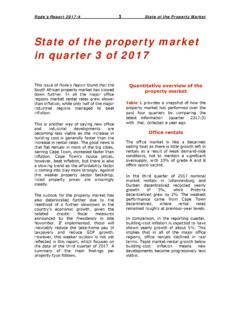Transcription of Annexure1 Glossary of property terms & abbreviations
1 Annexures Rode s Report 2010:4 annexure 1 IGlossary of property and related terms and abbreviations Arithmetic mean: The most often used measure of central tendency, it is the simple average of a number of observations. Mathematically, it is equal to the sum of all values divided by the number of observations. For example, the arithmetic mean of 6 and 7 is (6+7)/2. The arithmetic mean of 6, 7 and 8 is (6+7+8)/3; and so forth. Outlier observations may unduly affect the mean.
2 In the Rode publications all references to the mean refer to the arithmetic mean, unless otherwise specified. See also geometric mean and median. Besa: Bond Exchange of South Africa. BER BCI: Bureau for Economic Research Building Cost Index. Measures pre-contract non-residential building-construction prices and as such it includes the profit margin of contractors. This index is one of the best indicators of the health of the building-construction industry. If it accelerates faster than input costs (Haylett Index), then contractors are stretching their profit margins as a result of sufficient work, and vice versa.
3 Building construction: the construction of buildings like houses, office blocks, factories, shopping centres, schools, hospitals. See also civil construction. Bulk: The market value of office and shopping-centre land is generally expressed as the value per bulk square metre. Bulk square metres refer to the gross building area (GBA) of a building. According to The Sapoa Method for Measuring Floor Areas in Commercial and Industrial Buildings, GBA covers: The entire building area, but it excludes patios, plant boxes, sunscreening, escape stairs, machine rooms, parking (basements or above ground), lift motor rooms, service rooms, caretakers flats, etc.
4 GBA is mainly used by planning consultants in order to plan and execute a building in accordance with the permissible Floor Area Ratio ( ) as derived from the zoning of the is fixed for the life of the building but it should be noted that different local authorities may interpret the National Building Regulations which regulated the definition in a slightly different manner. Standard capitalization rate: It is the expected net operating income for year 1, assuming the entire building is let at open-market rentals, divided by the purchase/transaction price, normally expressed as a percentage.
5 This calculation ignores VAT, transfer duty and income tax, and assumes a cash transaction (in contrast to a paper-based sale). CBD: Central business district or downtown. This is an area of concentrated high economic activity. The user can differentiate between the metropolitan CBD ( the Johannesburg CBD) and a decentralized CBD (like the Sandton CBD). Civils: colloquial for civil construction. Rode s Report 2010:4 annexure 1 IICivil construction: the construction of physical infrastructure like roads, bridges, dams, the laying of stormwater pipes, electricity and water reticulation.
6 See also building construction. Cyclical trend: A short-term growth path of an economic variable. Normally refers to the business cycle, as distinct from a secular trend. Dec: Decentralized. A Rode abbreviation. Town and regional planners differentiate between local decentralization (from the metropolitan CBD to the suburbs) and regional decentralization (to outlying areas of the country). Deflation: Deflation occurs when prices are declining over time. This is the opposite of inflation and could be catastrophic.
7 When the inflation rate (by some measure) is negative for a period, the economy is in a deflationary period. See also disinflation. Deseasonalized: Seasonal fluctuations have been removed. In the case of retail sales, this is essential in order to be able to compare sales pertaining to different months of the year, as opposed to comparing sales of one quarter or month with the same quarter or month a year earlier. Discount rate: The rate used to express an expected future cash stream in present-value terms .
8 In most instances, the discount rate is equal to the hurdle rate. Mathematically, the hurdle rate of a property is the sum of its market capitalization rate and the expected constant growth rate of its cash flow in perpetuity. Disinflation: Disinflation occurs when the inflation rate is declining over time. See also deflation. Escalation rate: The rate by which a rental is hiked once a year in terms of a lease. The ruling market escalation rate can be seen as an attempt by the market to forecast the growth in market rentals over the duration of the lease, but this attempt is obviously rarely successful.
9 Thus it is important to differentiate between an escalated rental and a market rental. Forward (income) yield: A bourse term, hence it is typically applied to listed properties. In the non-listed property market, its approximate equivalent is the capitalization rate. It represents the expected net income of year 1 (the following 12 months) divided by the current price/value. It stands to reason that existing leases would largely determine the net income of year 1.
10 See also historic (income) yield. Fundamental value (FmV): It is a subjective value based on the investor s own, subjective forecast of rentals and maybe the investor s unique or different in-house discount rate/capitalization rate. A FmV higher than the objective market value (MV) is a buy signal to an investor. The calculation of the FmV is especially indicated where the economy, or property market, changes gear, a secular change in inflation rate or the real-rental cycle bottoming out.





